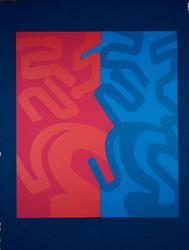After Metternich Drawings (Red-Blue)
After Metternich Drawings (Red-Blue) is a screen print by the artist Chryssa.
Chryssa Vardea-Mavromichali, known in the art world by her first name, was a Greek-born, American artist, who moved to New York City in the 1950’s. Already interested in depicting written communication and fragmented writing, Chyrssa was be struck by New York City’s bright advertisements and lights.1 This newfound inspiration and surroundings would go on to serve as an artistic catalyst for Chryssa.
It was in New York City where Chryssa realized the potential of neon tubing as an art medium and began incorporating it into her works while continuing to focus on the fragmentation of letters and symbols.2
This particular work, After Metternich Drawings (Red-Blue), tells us a slightly different story. Unlike her prints and sculptures that were inspired by her commercial surroundings, this print was commissioned by Countess Metternich, for her home in Kassel, Germany, and the shapes you see here, are inspired by the countryside around the castle.3
This makes the work unique in its influence, but the vibrant colors and fragmented shapes seen here are still distinctly characteristic of Chryssa’s style.
Something that I find exciting about this work is how the red-orange half of the work seems to jump forward, setting itself apart from the blue and creating a subtle, but eye-catching depth.
I interpret the forms as having a maze-like quality, as if Chryssa looked out the window of this castle and saw a manicured garden with a hedge maze. I also read some of the curved lines along the bottom of the composition as more water-like, perhaps representing a visible body of water.
The quality of not being able to give definitive meaning to Chryssa’s marks has long captivated her audiences. Even when critics expressed discomfort that they could not easily interpret the text in her works, Chryssa leaned into this unease, telling the Herald Tribune in 1966, “I have always felt that when things are spelled out they mean less, and when fragmented they mean more.”4
Does this fragmentation add meaning to the work for you or do you feel similarly to the critics, wishing for more clarity?
- Mallory Schultz, Art Collections & Exhibitions Fellow 2019 - 2020
[1] Margalit Fox, “Chryssa, Artist Who Saw Neon’s Potential as a Medium, Dies at 79,” New York Times, January 18, 2014, http://www.nytimes.com.
[2] Ibid.
[3] Vivien Raynor, “ART; Sculptures That Announce Themselves With a Blaze of Light,” New York Times, June 30, 1991, http://www.nytimes.com.
[4] Margalit Fox, “Chryssa, Artist Who Saw Neon’s Potential as a Medium, Dies at 79,” New York Times, January 18, 2014, http://www.nytimes.com.
Bibliography
- Fox, Margalit. “Chryssa, Artist Who Saw Neon’s Potential as a Medium, Dies at 79.” January 18, 2014. http://www.nytimes.com.
- Raynor, Vivien. “ART; Sculptures That Announce Themselves With a Blaze of Light.” New York Times. June 30, 1991. http://www.nytimes.com.

